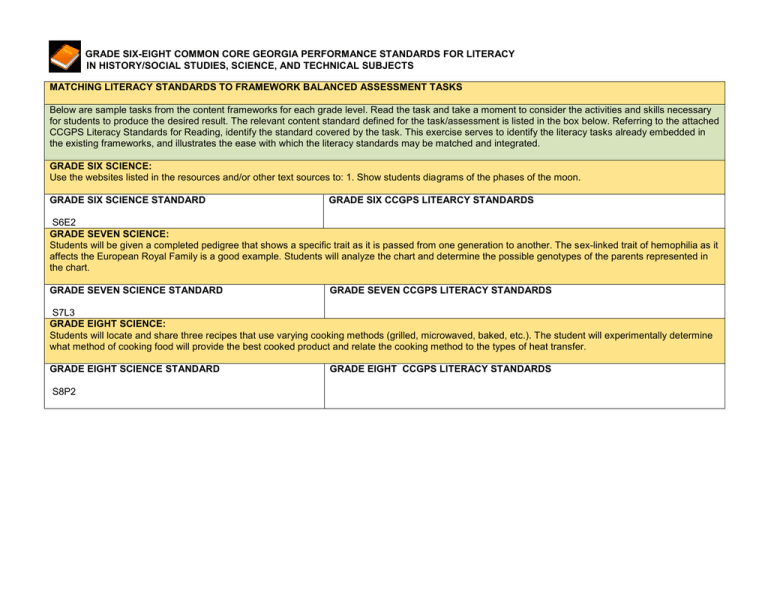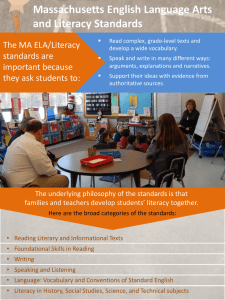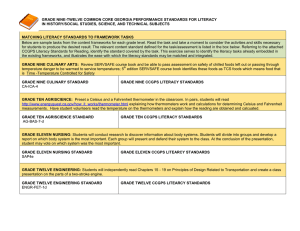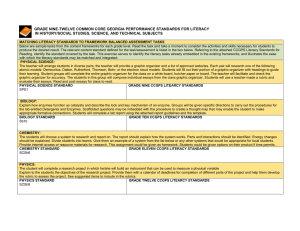6-8 Science Task - Georgia Standards
advertisement

GRADE SIX-EIGHT COMMON CORE GEORGIA PERFORMANCE STANDARDS FOR LITERACY IN HISTORY/SOCIAL STUDIES, SCIENCE, AND TECHNICAL SUBJECTS MATCHING LITERACY STANDARDS TO FRAMEWORK BALANCED ASSESSMENT TASKS Below are sample tasks from the content frameworks for each grade level. Read the task and take a moment to consider the activities and skills necessary for students to produce the desired result. The relevant content standard defined for the task/assessment is listed in the box below. Referring to the attached CCGPS Literacy Standards for Reading, identify the standard covered by the task. This exercise serves to identify the literacy tasks already embedded in the existing frameworks, and illustrates the ease with which the literacy standards may be matched and integrated. GRADE SIX SCIENCE: Use the websites listed in the resources and/or other text sources to: 1. Show students diagrams of the phases of the moon. GRADE SIX SCIENCE STANDARD GRADE SIX CCGPS LITEARCY STANDARDS S6E2 GRADE SEVEN SCIENCE: Students will be given a completed pedigree that shows a specific trait as it is passed from one generation to another. The sex-linked trait of hemophilia as it affects the European Royal Family is a good example. Students will analyze the chart and determine the possible genotypes of the parents represented in the chart. GRADE SEVEN SCIENCE STANDARD GRADE SEVEN CCGPS LITERACY STANDARDS S7L3 GRADE EIGHT SCIENCE: Students will locate and share three recipes that use varying cooking methods (grilled, microwaved, baked, etc.). The student will experimentally determine what method of cooking food will provide the best cooked product and relate the cooking method to the types of heat transfer. GRADE EIGHT SCIENCE STANDARD S8P2 GRADE EIGHT CCGPS LITERACY STANDARDS LITERACY STANDARDS FOR READING IN SCIENCE AND TECHNICAL SUBJECTS (RST) GRADES 6-8 Key Ideas and Details L6-8RST1: Cite specific textual evidence to support analysis of science and technical texts. L6-8RST2: Determine the central ideas or conclusions of a text; provide an accurate summary of the text distinct from prior knowledge or opinions. L6-8RST3: Follow precisely a multistep procedure when carrying out experiments, taking measurements, or performing technical tasks. Craft and Structure L6-8RST4: Determine the meaning of symbols, key terms, and other domain-specific words and phrases as they are used in a specific scientific or technical context relevant to grades 6–8 texts and topics. L6-8RST5: Analyze the structure an author uses to organize a text, including how the major sections contribute to the whole and to an understanding of the topic. L6-8RST6: Analyze the author’s purpose in providing an explanation, describing a procedure, or discussing an experiment in a text. Integration of Knowledge and Ideas L6-8RST7: Integrate quantitative or technical information expressed in words in a text with a version of that information expressed visually (e.g., in a flowchart, diagram, model, graph, or table). L6-8RST8: Distinguish among facts, reasoned judgment based on research findings, and speculation in a text. L6-8RST9: Compare and contrast the information gained from experiments, simulations, video or multimedia sources with that gained from reading a text on the same topic. Range of Reading and Level of Text Complexity L6-8RST10: By the end of grade 8, read and comprehend science/technical texts in the grades 6–8 text complexity band independently and proficiently.





